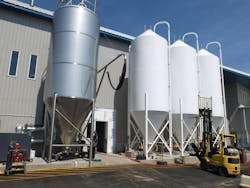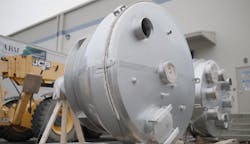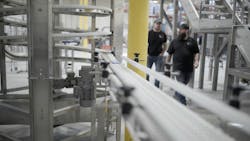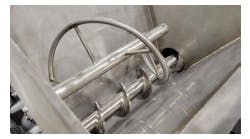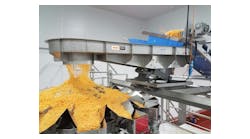A guide to weighing and batching system basics
Sept. 6, 2024
Designing and implementing a bulk weighing and batching system requires careful consideration of the products being handled, selection of the appropriate equipment, and partnering with a reliable integrator. This guide will provide a basic overview of bulk weighing and batching systems, including the types of products handled, the equipment used, and the criteria for selecting equipment and integrators. While all the regulations applicable to each area and product are much too involved to cover in an article such as this, a knowledgeable system designer or integrator will typically be able to bridge the gap.
Common products and requirements
The type of product being handled in a bulk weighing and batching system is the first fork in the road when determining which equipment will promote optimal material flow.
Food products. As regulations have tightened, pet food applications are starting to be treated the same as human food applications. The biggest distinction is between pre- and post-processing. Before a kill-step such as boiling, carbon steel product surfaces are fine. Post-processing, stainless steel is required for its corrosion resistance and preferred for its ease of cleaning. A maximum finish of 32 RA is allowed on stainless, but better finishes will make cleaning easier and more effective. RA stands for roughness average, or how rough a surface is, so a maximum value is the minimum amount a surface — particularly the product contact area — should be polished. Note that RA is not an actual unit of measure; microinches are the standard unit unless otherwise specified in the US, and micrometers are usually the default elsewhere.
Pharmaceuticals. Because smaller quantities are being handled and ratios are much more important than in food applications, pharmaceutical manufacturers will always require smaller-scale, more accurate equipment, at least accurate to a decimal place past the maximum allowed variance. To manage cross-contamination risk, a maximum RA of 20, and sometimes down to 15 is required, but often these values are exceeded by a mirror finish, which is 6-12 RA, so looking for “mirror” or “electropolish” finish is a common way to ensure that equipment meets this spec. Note that electropolishing is a polishing method rather than a specification. Generally, it is only used when necessary and can be trusted as an indicator, but technically extremely rough steel could be electropolished and not come remotely close to the RA requirement.
Chemicals. The term “chemicals” covers a wide range of materials. Some can be held in plastic, some need mirror-finished stainless and some — such as those used in maraschino cherries — will eat through anything, including mirror-finished stainless. Best practice for such extreme applications is to forget stainless scales altogether and simply put a lipped stainless plate over the scale platform. This will protect the load cells and cost much less to replace when it corrodes. Explosion protection considerations, precision, and materials will vary too wildly for the scope of this overview.
Construction materials. Abrasion is the main concern with construction materials such as cement, sand, and aggregates. Carbon steel is usually acceptable, but friction between equipment and the product should be minimized wherever possible. Bolt-on paddles and arms are used in mixers and tumblers, belt conveyors are the preferred method of transport, and product is preferably weighed during conveyance.
Bulk weighing and batching system equipment
Storage silos. Silos can be anything from polymer to stainless, but the two most common types are smooth-wall (pre-welded) and bolt-together. Smooth walls are usually ideal and are typically made of carbon steel that is powder-coated on the outside to protect it from the elements. Stainless is used for wet products, but usually silos are used for incoming, dry, pre-process or raw materials. The other common type of silo is the bolt-together, which is dramatically cheaper but much more difficult to assemble. Further, bolt-together silos are not suitable for many products because they rust more easily and have much shorter lifespans, especially when being filled by truck because the pneumatic silo lines constantly cause them to expand and retract, creating excessive wear. Silo capacities range from about 8,000-lbs. (of grain) up to about 80,000 lbs. The average silo capacity is about 20,000-lbs., and it is recommended to buy them as soon as you can use the volume because commodities pricing is heavily volume-sensitive.
Bulk bag unloaders. An intermediate step between 50-lb. bags and silos, bulk bag unloaders let processors buy product in bulk bags or super sacks, which hold about 2,000 lbs. of grain. Standard configurations require a forklift to lift bags onto the unloader’s frame, though hoist-and-trolley units are available at nearly double the cost. When necessary, however, the extra cost of these units is worth the savings in labor and material costs.
Hoppers and bins. Hoppers and bins are commonly made to order for whatever dimension is going to maximize the space available or required for the system. They can be necessary to mix in, provide a staging area between batch and continuous equipment, or to add product into an otherwise closed conveying line. They are available in plastic and metal, and for dry materials they can either be connected to an external dust collection system by ports or have one on the unit. Auto-pulse bag dumps will start to draw air in when the lid is lifted, and reverse-pulse the filters when the lid is closed to return the product to the process.
Weighing scales and load cells. Scales are generally classified into lab, bench (just small enough for a table but usually put on the floor), floor, and hanging. They are available in various materials but are usually stainless. NTEP certifications are not required for batching and internal use, only for when product is being sold based on weight. For repair and calibrations — whether NTEP or not — local scale companies typically offer service agreements where they come calibrate the scales periodically.
Load cells will differ in material and configuration depending on whether they are being compressed or pulled, but local scale companies will know which is best. Load cells are commonly placed under equipment — whether vibrating or not — to get readings where desired. But when weighing into a batch system, it is usually more efficient to feed everything into a single hopper on load cells, called a scale package, and weigh everything at one point rather than to put every vessel on load cells. Filler feedback — when a filler is told to stop or start based on feedback, i.e. stop filling because the hopper is full — can be managed from a scale package just as it is from a vessel. This will be covered more extensively in the software section.
Conveyors. Conveyor type is another big topic that is best determined with the help of an integrator. Common conveyor types include screw, auger, vibratory, tubular drag, roller, magnetic and bucket, as well as flat, tube, corrugated and cleated belt conveyors. There are many factors, including flow rate, material, distance, power, slope, cleanliness requirements, etc., but each factor is simple, and a process engineer will know what is best. The main thing to think about with conveyors and control systems is cohesion, because conveyors are the skeleton of the system that holds all the organs together. It is nice to be able to have everything tied into the same tubular drag or pneumatic system, for example, which is the most common method for weighing and batching. There will be instances where another method will be better, however, and using the best method at each step is usually worth it.
Mixers and blenders. The line between mixers and blenders is fine and depends on the amount of shear the equipment imparts to the product. Some products are more resilient than others, so the same machine may be called a mixer in one application and a blender in another.
Mixers are available with a number of features to improve efficiency, such as applying vacuum and microwaves, but the most common distinctions are between the agitators. Paddle mixers are the most gentle, low-shear option and work with powders but are not good with materials that are extremely runny, sticky, or thick. Ribbon mixers are extremely efficient, even with the runniest materials but do not function well with sticky materials and create too much shear for others. For this reason, they are often called ribbon blenders. Hybrid mixers combine the two methods and carry some of the same mixing patterns. Most hybrid mixers are ribbon/paddle, but these are still not good for sticky materials. For sticky materials, ribbon/fluidizer hybrids are usually best. Other, less common but still prevalent methods are tumble, conical and vertical mixers.
Another popular method is the V-blender, which is a V-shaped vessel that rotates slowly on a horizontal axis to gently tumble and mix the material inside. Though they are most commonly called blenders, they could be referred to by either term because they are very gentle. For that reason, they are the most popular method for pharmaceuticals.
The most common types of blenders are ribbon blenders, plow blenders, and fluidizers. Fluidizers and plow blenders both use paddles that are designed to create shear, each creating different blend patterns with varying effects on different products. One of these methods is generally standard for most products, but the only way to truly find out which is best for a new product is through testing.
Control systems. While each piece of equipment will have a standard programmable logic controller (PLC) configuration, weighing and batching systems generally have multiple pieces of equipment chained into one, which is controlled on the floor by a human machine interface (HMI), typically a touch screen that shows operators which equipment they are affecting and how they are affecting it. These methods of operation will not be going away anytime soon, but some HMI functions are now also being handled by site-wide control software that is accessible from managers’ desktops. More powerful software is not only able to use plant-wide data to generate helpful reports for decision making, but it can combine functions of other software, such as enterprise resource planning (ERP) software to enact equipment control. For example, if a plant is low on a product, the system can shut off or use a substitute. A number of packages are available, from DSO Sentinel for small operations to FactoryTalk for large ones.
Dust collection systems. Dust collection is helpful for most processes involving powders because it keeps the air and floor clean, deterring pests. It is also required by law where combustible dusts are present to minimize fire and explosion risk. There has been a recent surge in demand for these systems because of tightened NFPA standards, so when in doubt, be sure to find out if dust collection is required for your product.
Cartridge dust collectors use pleated filters to capture small particles. They consume little space and are easy to maintain but will fill quickly in high-volume applications because there is little room for fabrics of descending micron size.
Baghouse dust collectors use a series of bags, allowing plenty of space to filter materials progressively, but they require a large footprint, and bag changes often require a service provider.
Cyclone dust collectors use centrifugal force rather than filter media to separate particles from the airstream and, therefore, can accommodate huge volumes with low maintenance demands, but they are large and do not capture small particles.
How to select equipment
Equipment selection is usually handled by a systems integrator because a lot goes into each decision and it is fastest to have someone already familiar with all the options.
Choose an integrator. A system integrator is necessary when installing a system with multiple pieces of equipment to manage product flow from piece to piece. Also, OEMs are in the business of achieving economies of scale on their products. With a good integrator, every other step in this section can be bypassed.
Find an integrator that specializes in your product type, whether it is liquids and slurries or dry solids, and that has experience in your specific industry and the materials you handle. Find out what they do in house and what they outsource. A lot goes into a system, and it is ideal to find someone who designs the system, builds the transitions, modifies equipment, installs the system, and services the equipment all under one roof.
Define requirements. Understanding the physical and chemical properties of the materials to be handled is critical. The most important metrics for equipment quotes are the product type (for equipment specs), bulk density, volume, and tendency to bridge. For example, abrasive products may be more suitable for belt conveyors rather than screw or pneumatic conveyors. For pneumatic conveying, denser products will use dense-phase conveying, while lighter products will use dilute-phase conveying. There are also different equipment configurations depending on the application. Environmental factors such as humidity and altitude must also be considered.
Evaluate technology and OEMs. It has long been a rule of thumb that larger manufacturers have more overhead but more reliable support. Recently, however, large equity groups have been purchasing OEMs and raising prices while reducing support, so it is a good idea to get recommendations from peers or someone who knows the space in addition to sales presentations and price comparisons.
The equipment’s country of origin can be an important factor; Chinese equipment has a reputation for breaking down faster and being more difficult to get spare parts for. Maintenance, cleanability, and available support are also important. Compare the features available between models to select the best one for your product. Depending on the product, there may be models designed with your specific product in mind.
Regulatory compliance. Ensure that all equipment and processes comply with relevant industry regulations and standards, such as FDA or local municipalities.
Safety. Implement safety measures to protect workers and prevent accidents. This includes proper guarding of equipment, emergency stop functions, and regular safety training.
Energy use. Energy cost will be a significant factor in your operating expenses, and energy availability can easily restrict your choices of location. Factor energy use into the cost of equipment and make sure there will be enough draw for anticipated growth.
Scalability and flexibility. If you plan to grow within your current space, select equipment that can be easily scaled or adapted to future production increases or changes. For example, more tubing can be added to a pneumatic conveyor to extend it, and an extra belt conveyor can be added to existing ones, but a screw conveyor would need to be cut. Modular systems are also available for a number of equipment types, so you can add functionality as needed.
Cost and value. This is the most obvious and most difficult consideration because everything depends on what you need. Get presentations, compare them, and pull the trigger. Everything can be fixed, so avoid analysis paralysis.
Conclusion
By understanding the product’s specific requirements, selecting suitable equipment, and partnering with experienced professionals, processors can ensure a weighing and batching system that is efficient, accurate and reliable. Investing time and resources into planning and selecting the right components will yield long-term benefits in terms of product quality, operational efficiency and profitability.
John Hilgendorf is the marketing manager for ABM Equipment, a bulk dry solids handling and processing equipment solutions supplier providing full-service system design, fabrication, integration and maintenance with 40 years of experience in the food industry.
ABM Equipment
Sponsored Recommendations
Sponsored Recommendations

